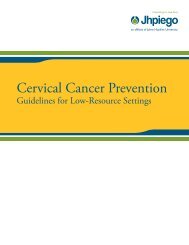Manual for Male Circumcision under Local Anaesthesia
Manual for Male Circumcision under Local Anaesthesia
Manual for Male Circumcision under Local Anaesthesia
You also want an ePaper? Increase the reach of your titles
YUMPU automatically turns print PDFs into web optimized ePapers that Google loves.
<strong>Male</strong> circumcision <strong>under</strong> local anaesthesia<br />
Version 3.1 (Dec09)<br />
POST-EXPOSURE PROPHYLAXIS<br />
Health care workers may be accidentally exposed to blood and other<br />
body fluids that are potentially infected with HIV, hepatitis virus or<br />
other bloodborne pathogens. Occupational exposure may occur<br />
through direct contact of non-intact skin with potentially infected blood<br />
or body fluids, from splashes into the eyes or mouth, or through injury<br />
with a used needle or sharp instrument. Post-exposure prophylaxis<br />
(PEP) can help prevent the transmission of pathogens after such a<br />
potential exposure.<br />
Managing occupational exposure to hepatitis B, hepatitis C and<br />
HIV<br />
The immediate response to exposure to blood or other fluids that are<br />
potentially infected with hepatitis B virus (HBV), hepatitis C virus<br />
(HCV) or HIV is as follows.<br />
Step 1. Provide immediate first aid care to the exposure site:<br />
• If a splash or a spill occurs on the skin, wash the area<br />
immediately with soap and water. Do not use caustic agents,<br />
alcohol or bleach, because they will irritate the skin and may<br />
increase the risk of infection. Do not apply a dressing.<br />
• If a splash or a spill occurs in the eyes, the nose, the mouth, or<br />
on any mucous membrane, rinse the area with clean water <strong>for</strong><br />
at least 10 minutes.<br />
• If an injury has been caused by a potentially contaminated<br />
sharp, wash the area with soapy water, and allow the wound to<br />
bleed freely <strong>for</strong> a few minutes if possible. Then give normal first<br />
aid.<br />
Step 2. Evaluate the risk by determining the type of fluid (blood, visibly<br />
bloody fluid, or other potentially infectious fluid), the severity and type<br />
of exposure (percutaneous or needle stick, mucous membranes, intact<br />
or non-intact skin), and the source of infection.<br />
Step 3: If the source person is identified, it is important to try to obtain<br />
in<strong>for</strong>mation on his or her hepatitis and HIV serostatus and, if positive,<br />
an evaluation of the clinical status and treatment history.<br />
• Assess the risk of infection, using available in<strong>for</strong>mation.<br />
• The source person may be tested only with his or her in<strong>for</strong>med<br />
consent.<br />
• Do not test discarded needles or syringes <strong>for</strong> virus<br />
contamination.<br />
Management of exposure to hepatitis B<br />
The medical response to exposure to hepatitis B virus (HBV) depends<br />
on the patient's immune status, as determined by the history of<br />
hepatitis B vaccination and vaccine response, and whether the<br />
exposure poses a risk of infection. Transmission of HBV may occur<br />
Prevention of Infection Chapter 8-16
















